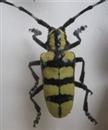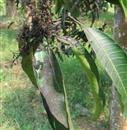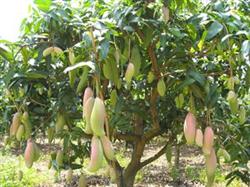How to control the mango longicorn beetle

Distribution and harm situation have occurred at home and abroad, Yunnan, Guangdong, Guangxi, Fujian and other places have different degrees of occurrence. Larvae eat mango, cashew and other fruit tree branches, usually from the young branches invasion, gradually down to the big branches, trunk, seriously affect the growth potential of the plant, eventually leading to the death of the whole plant. Morphological characteristics Adult body length about 33 mm, width about 8 mm, chestnut or chestnut black, narrow body, parallel on both sides, between the antennae, around the compound eyes and the top of the head dense golden hair, longer antennae, about 1/2~3/4 of the body length, pronotum has 19 raised longitudinal ridges, longitudinal ridges between the deep groove cluster pale yellow hair. The elytra surface is densely engraved, the base is thicker and densely wrinkled. In addition to the short gray hairs, there are long stripes composed of golden hairs arranged in five longitudinal rows. The ventral surface and feet are densely gray or gray-brown villi. Life habits occur one generation a year, adults occur in April to July, May, June a large number of emergence. Adults often lay eggs in the cracks or crevices near the end of young branches, one at a time, hatching larvae that drill into the pith of branches to eat, the tunnel is simple, cylindrical from top to bottom, and white jelly is often gathered at the end of the tunnel. Vibrating branch larvae can move up or down rapidly, and the outer parts of the injured branches are separated by a certain distance and have defecation holes. Insect faeces are discharged as a viscous black liquid through the defecation holes, which is a significant sign of the insect's harm. The larvae pupate in the tunnel after maturity, stay in the pupal room for a period of time after emergence, bite and widen the defecation hole, go out to move, nibble on young branches, buds and tender tip skin for supplementary nutrition, mate and lay eggs. Control measures 1. Clean orchard winter, spring orchard pruning, pruning damaged branches, concentrated burning. 2. Artificial killing of newly emerged adults is convenient for artificial capture during the feeding stage of supplementary nutrition. 3. Crown spraying uses adults to supplement nutrition and poison at feeding stage. Some low-toxicity pesticides can be selected for spraying. For example: 25% or 30% Jule mixture emulsifiable concentrate 1500~2000 times solution, or 20% Guofengling wettable powder 800~1000 times solution or 30% Shachongling emulsifiable concentrate 1000~1500 times solution. One of the above pesticides is used alternately. The adult generation period is 7~10 days. Spray once, and spray 2~3 times continuously. 4. Insect holes are injected with 50 times solution of medicinal 40% dimethoate emulsifiable concentrate, 200 times solution of 2.5% cymethrin emulsifiable concentrate, or 100 times solution of 80% dichlorvos emulsifiable concentrate. Use a syringe to directly inject the liquid medicine into the insect holes or insert absorbent cotton into the insect holes with the liquid medicine, and then plug the holes with wet mud. Note: Before using medicine, choose the hole discharged by fresh insect faeces to inject medicine or plug cotton wool. Then plug all the dung holes of the whole tree with wet mud, so as to facilitate the pesticide fumigation of the larvae in the pesticide channel. Click for more mango growing techniques Click for more fruit growing techniques
- Prev

How to prevent mango soot disease
What's big mango soot? How to control fungal diseases. At present, 6 pathogens causing mango soot disease have been found in China. It damages leaves, branches and fruits, affecting leaf photosynthesis and fruit appearance. Prevention and control methods: one is reasonable dense planting, pruning, keep canopy ventilation and light transmission....
- Next

How to manage the mango orchard?
To strengthen the comprehensive management of mango orchard is to achieve the goal of high yield, stable yield, high quality and improve economic benefit by promoting the robust growth of the tree. Specifically, we should start from the following aspects: first, soil farming should be fine. To ensure that the surface growth layer of good soil aggregate structure, taboo soil consolidation, protection.
Related
- Moge, come on! The staff of the peasant association in the producing area of cantaloupe were frightened when the crowd gathered.
- Causes and Solutions of low Fruit setting rate of Apple
- Symptoms and control measures of passion fruit virus disease
- Fruit growing lesson: how do apple orchards keep high yields?
- Can you build orchards in the mountains? What are the pros and cons?
- How to manage the coloring period of Crisson grape?
- This paper introduces the processing technology of two kinds of fig products.
- How much is a month for retired teachers in rural areas by 2020?
- How can strawberry planting increase sugar content? We should pay attention to management in many aspects.
- What are the cultivation techniques on how to improve the yield of golden fruit?

